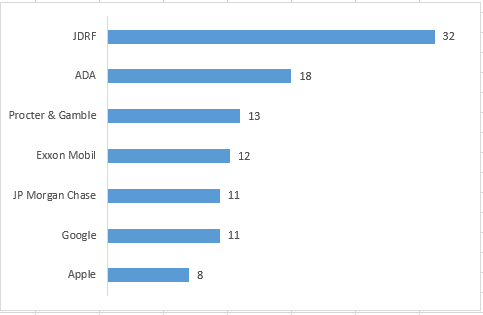
COMPARISON OF THE NUMBER OF BOARD MEMBERS AT EACH ORGANIZATION.
The board of directors at JDRF and the ADA ultimately have more influence over spending and strategy than anyone else at the organization. Board members set the organization’s strategic direction and have the final say in funding allocations. As such, they have the significant ability to set priorities and accelerate cure progress.
In our third annual report regarding the role of the boards of directors, little has changed. Boards are still surprisingly large; still composed mainly of wealthy individual donors; and still selected from an internal population rather than elected by a broad base of donors. Compared to a for-profit corporation, where each member of the board is deeply involved in insuring that the organization fulfills and delivers its mission, the non-profit boards seem more ceremonial than operational.
The following is a list of several recommendations for addressing a few systemic problems and building a high impact board:
- Holding board members externally accountable. Non-profit board members can only be appointed or removed by fellow board members, which consolidates power in an insulated bubble. Board member election by a broad base of donors would create accountability and ensure alignment with the donor base.
- Decreasing the number of members on the non-profit boards. JDRF has 32 members and the ADA has 18. In contrast, effective boards in many high performing organizations have between 8-14 members -- large enough to bring a range of skills and experience to the table but small enough to have a meaningful and fully engaged discussion. See Opening Chart.
- Adopting and making transparent annual measures to track cure progress. The non-profits have no clear way to evaluate whether or not the executives who are accountable to them are making progress towards the cure goal if they do not set annual performance metrics for cure progress. Such measures should be shared with the general public and would drive performance. A key role of all board members should be to hold the management team responsible for achieving the direction the board has set.
- Reporting on progress in a more frequent, timely, and comprehensive manner. The non-profits only communicate performance in annual reports that come out months after the year-end. More regular, comprehensive reporting on progress would allow donors to stay up to date about progress and make informed giving decisions. Additionally, better communication practices would deepen trust with donors, which would ultimately boost giving to the non-profits.
Image credit: www.shutterstock.com
